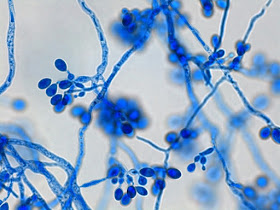Scedosporium
prolificans -Fungus
(Previously known as Scedosporium inflatum)
Ecology: Scedosporium
prolificans is a cosmopolitan fungus isolated primarily from
soils (saprophyte), however its ecosystem and distribution may be
more restricted than the other major species, Scedosporium apiospermum. Scedosporium prolificans has been isolated
from hospital settings after the environment was disturbed during
on-site construction.
Macroscopic Morphology:
S.prolificans exhibits moderately rapid spreading growth and
will mature within 5 to 7 days at 25oC on sabouraud
dextrose agar (SDA or SAB). Young suede-like to downy growth becomes
increasingly cottony as it develops an olive-grey to a black
colouration. Light coloured mycelial tufts may develop as the colony
ages. Reverse is a dark brown to dark grey, almost black in
appearance.
Scedosporium prolificans SAB, 72 hrs, 30oC
 Microscopic Morphology: Scedosporium prolificans produces hyaline septate hyphae from
which conidiogenous cells are produced along the length. The
conidiogenous cells are flask-shaped annellides which have a swollen
base (inflated) from which extends an elongated 'neck'. Conidia are
produced singly or in small groups at the apex of the annellide. The
smooth walled single-celled conidia are hyaline to a pale brown in
colour and are oviod to pyridaform in shape. These conidia
(annelloconidia) have a truncated base where they were attached to
the conidiogenous annellide. The conidia measure 2 - 5
μm
to 3 - 13 μm
(average 3.4 μm
to 5.3 μm)
in dimension.
Microscopic Morphology: Scedosporium prolificans produces hyaline septate hyphae from
which conidiogenous cells are produced along the length. The
conidiogenous cells are flask-shaped annellides which have a swollen
base (inflated) from which extends an elongated 'neck'. Conidia are
produced singly or in small groups at the apex of the annellide. The
smooth walled single-celled conidia are hyaline to a pale brown in
colour and are oviod to pyridaform in shape. These conidia
(annelloconidia) have a truncated base where they were attached to
the conidiogenous annellide. The conidia measure 2 - 5
μm
to 3 - 13 μm
(average 3.4 μm
to 5.3 μm)
in dimension.
Note: All photographs which follow were taken using the Leica DMD-108 digital microimaging device.
Scedosporium prolificans (LPCB, 250X) -First impression of a slide culture.
Scedosporium prolificans -hyphae with conida visible. Conidiogenous cells not all that distinct at this magnification, (LPCB, 400X)
Scedosporium prolificans -another view of conidia along hyphae
(LPCB, 400X)
Scedosporium prolificans - conidia seen distributed singly and in clusters along the hyphae. (LPCB, 400X)
Scedosporium prolificans - At this magnification the conidiogenous cells are becoming more obvious. Ovoid to pyridaform conidia can be seen attached at the apex of the annellide. Note 100 micron bar at upper right. (LPCB, 400+10X)
Scedosporium prolificans - Here we can see a conidiogenous cell (annellide) extending from the hyphae at which four annelloconida can be seen at the apex. (LPCB, 1000X)
Scedosporium prolificans - hyphae with annellides bearing ovoid to pyridaform annelloconidia. (LPCB, 1000X)
Scedosporium prolificans - Here we can distinctly see the inflated, vase-like annellide conidiophore (arrows) from which are produced the annelloconidia. (LPCB, 1000X)
Scedosporium prolificans - Here we can see the elongated 'neck' (1) at the apical end of the annellide and the truncated base or scar at the end of the annelloconidia where it was once attached (2). The swollen or inflated vase like base is evident just right of (1) where the conidiogenous cell attaches to the hyphae. (LPCB, 1000X)
Scedosporium prolificans - Here again we can see the elongated 'neck' (1) with an annelloconidia at the apex, the inflated annellide (2) and the annelloconidia, each with a flattened, truncated base of attachment (3).
(LPCB, 1000X)
Scedosporium prolificans - Measurement of annelloconidia - 7.0
μm
to 7.4
μm
in length, 4.7
μm
in diamenter in this field. (LPCB, 1000+10X)
Scedosporium prolificans - small clusters of conidia (annelloconidia) at the apex of annellides (conidiogenous cells) extending from hyphae.
(LPCB, 1000+10X)
Scedosporium prolificans - one last photo showing branched septate hyphae with annelloconidia at apex of annellides. (LPCB, 1000+10X)
Pathogenicity:
Scedosporium prolificans
is an emerging fungal pathogen can infect both immunocompetent and
immunocompromised individuals. Noted risk factors for scedosporiosis
have included malignancy, cystic fibrosis as well as solid organ
transplantation. Onychomycosis and mycotic keratitis have been
reported in the literature. Inhalation of the fungus has resulted in
colonization of the paranasal sinus and the lungs. Penetrating
injuries may result in localized infections of the joints resulting
in septic arthritis as well as osteomyelitis. Disseminated
have been reported in immunosuppressed patients such
as those experiencing prolonged neutropenia and post-transplantation
therapy. Accurate identification is imperitive as S.prolificans
exhibits increased resistance to common antifungal medications and
disseminated infections is often fatal even in immunocompetent
patients. Asymptomatic colonization as also been reported.
Differentiation:
Scedosporium
prolificans can be
differentiated from Scedosporium apiospermum as the
former has a distinctive swollen (inflated) base. This inflated base
was the reason this fungus was previously known as Scedosporium
inflatum.
S.prolificans produces annellides that are flask-shaped, unlike the
cylindrical conidiogenous cells of S.apiospermum.
S.prolificans is
inhibited by media containing cycloheximide. Finally, S.prolificans has no sexual stage (telemorph) as does Scedosporium apiospermum/Pseudallescheria boydii.
* * *








































